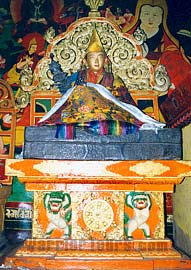Tibetan Buddhism
Tibetan Buddhism is also called Lamaism. It was introduced in the 7th century during the reign of Songtsen Gampo in Tibet. At that time, the Tibet was unified and had identified their own characters. To reinforce the regime, Songtsen Gampo attached great importance to the Buddhism and married princesses from Nepal and the Tang Dynasty (618-907), both of where the Buddhism prevailed. With these two princesses, a large amount of sutra and statues of Buddha were brought in to Tibet.
During the days of Trisong Detsen Tsampo, Songtsen Gampo's grandson and also son of another princess Jin Cheng, he invited Indian Buddhist master Padmasambhva to impart Esoteric Buddhism. Then the master chose seven talented Tibetans to tonsure and enter into this religion, thus they became the earliest monks of Tibet. Since then, there appeared a great many of monasteries and monks, and sutras were translated into Tibetan.
Afterwards, although Tibetan Buddhism underwent oppression, it continued to thrive from the 10th century and took into ten sects. Today those ten sects have changed and combined to five main ones:

![]() Nyingmapa (Red Hat Sect)
Nyingmapa (Red Hat Sect)
Nyingmapa in Tibetan means 'old sect', which suggests it is a branch of the Tibetan Buddhism with the longest history. As the disciples wore red hats and clothes, this sect was also called Red Hat Sect. Integrated with the teachings of Tantras and Bon, the primitive religion of ancient Tibet, its core is Dzogchen - through cultivating themselves through meditation, the followers can disentangle from mortal and become Buddha.
![]() Kagyupa (White Hat Sect)
Kagyupa (White Hat Sect)
Kagyupa followers wore white hats and clothes at first. It had widespread branches, but the mutual doctrine is the emphasis on dzogchen and theoretical study and belittling of fixed content in articles. They succeeded the principles by dictation of Esoteric Buddhism.
![]() Gelugpa (Yellow Hat Sect)
Gelugpa (Yellow Hat Sect)
This sect was formed in the early 15th century. It is the latest but the largest one among those Tibetan Buddhist sects. Initialized by Tsong Khapa, Gelugpa was highlighted by the combination of Esoteric and Exoteric Buddhism, as well as mitzvah. All of disciples of Gelugpa wear yellow cassock and hat, which gives their sect the other name 'Yellow Hat Sect'. There are also many splendid monasteries like Ganden Monastery, Drepung Monastery, and Sera Monastery.

![]() Sakyapa (Stripe Sect)
Sakyapa (Stripe Sect)
Sakyapa in Tibetan means white land. Since the main monastery Sakya Monastery was built on white land of river valley; and the bounding walls were painted with red, white and black flower patterns which indicated Manjusri, Avalokitesvara and Vajrapani Bodhisattva. Therefore, the sect was named Sakyapa and 'Stripe Sect'. It claims that believers should get rid of common earthly ideas and meditate the principles to achieve wisdom.
![]() Kadampa
Kadampa
The title of Kadampa sect suggests to teaching people the thoughts of Buddhism. It studies mainly the Exoteric Buddhism and then the Esoteric Buddhism. The Exoteric one emphasizes philosophical teachings that can be imparted to anyone. As the Yellow Hat Sect rose in 15th century, Kadampa tended to be substituted by it.

